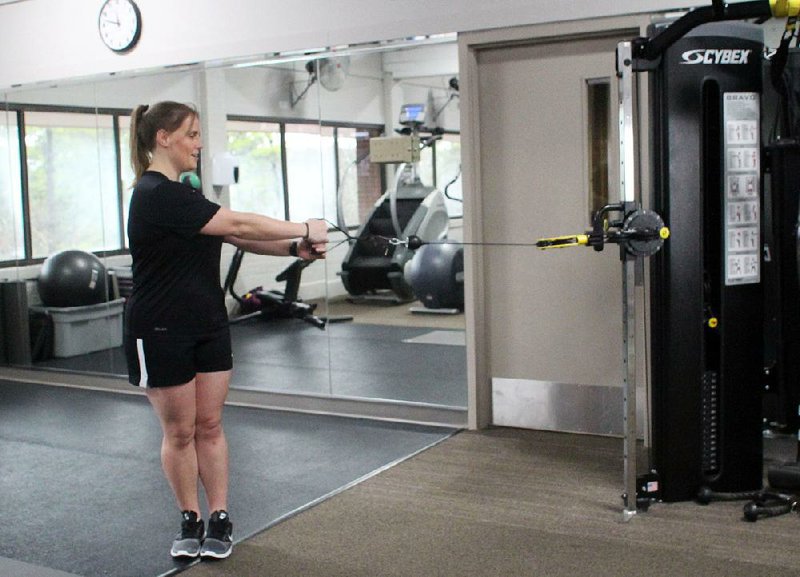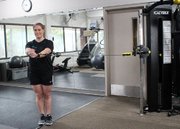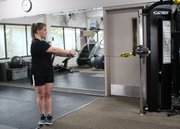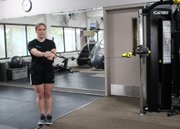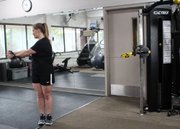The transverse plane is an imaginary plane that splits the human body into superior (top) and inferior (bottom) body parts.
Compared to other planes of movement, the transverse plane is relatively underutilized in strength training.
In other words, most of the time we exercise our bodies while moving back and forth or side to side. We don't tend to do a lot of rotating in the gym.
But we should do some.
In the world of kinesiology, we categorize movements by the plane in which they take place. We have three planes: the frontal, the sagittal and the transverse.
It helps to look at pictures, and you can find them easily online. But for now, imagine a manikin made of something easy to slice, such as clay. Take a thin, imaginary sheet of metal and slice it straight down through the manikin's head, neck, shoulders and body so you divide the front of the manikin from its back. Congratulations, you have found the "frontal plane."
The sagittal plane divides the body into sides (right and left). Using imaginary metal sheets to do that can cause some cognitive distress (you have to slide a second metal sheet in perpendicular to the first -- through a clay body that already has a metal sheet stuck in it). So don't try. Instead, just know that during strength training, most movements take place in the sagittal and frontal planes -- especially if the goal is to isolate specific muscles.
For extra credit, try to figure out why standard exercises such as the bicep curl, leg extension and abdominal crunch are said to occur in the sagittal plane, as joints move front to back parallel to that metal sheet. Meanwhile, the frontal plane features side-to-side movements such as lateral raise, hip abduction/adduction and other common exercises.
Then comes the "transverse plane." It is rarely chosen for exercise intentionally, although some exercises include small elements of transverse plane activity. Wrist pronation and supination (rotation of the wrist) occurs in the transverse plane, which is present in many versions of dumbbell exercises ranging from overhead press to one-arm row.
All joint rotation occurs within the transverse plane. While there are only a few areas of the body that can physically perform rotation, engaging in this movement pattern can provide valuable injury prevention for the common exerciser. Spinal rotation can occur at the cervical or thoracic sections, shoulder rotation occurs during many rotator cuff movements, and hip rotation occurs almost anytime we change direction.
The benefits of targeting the transverse plane are readily seen in the rehabilitative realm, when you need to rehabilitate or prevent an injury. Some people use the term "pre-habilitation" for such work.
By focusing on rotation (and the transverse axis), we can engage muscle groups in a different way that shores up our body's musculoskeletal defenses. However, rotational exercises can be complicated.
This week's exercise provides a nice introduction to the category, as the cable twist is something many have seen before. I've made some slight adjustments to allow more focus on each segment of the rotation. I think you'll dig it.
1. Position a cable machine pulley somewhere between chest and waist level. Attach a single handle. Stand sideways so that your left shoulder faces the pulley and the right faces away from it. Plant both feet as close together as you can get them, almost touching.
2. Grasp that single handle with both hands by twisting your torso to the left with your arms outstretched. This is your starting position and you should have tension on the cable.
3. Twist to the right until the handle is straight out from your chest, and then rotate back to the start. Do five repetitions like this.
4. Change your starting position. The arms should be straight out from the chest (your end point of the last set).
5. Twist all the way to your right until you're 180 degrees from the pulley with both shoulders facing away from it. Go back to center and continue this pattern for five repetitions.
6. Finally, perform five full twists by going the full range of motion from the pulley and all the way to your right.
7. Do one set of 15 repetitions, then switch sides and repeat.
Rotation is a great way to add some spice to your existing routine while infusing a little pre-habilitation along the way. Enjoy!
Matt Parrott has a doctorate in education (sport studies) and a master's in kinesiology and is certified by the American College of Sports Medicine.
vballtop@aol.com
ActiveStyle on 03/12/2018
